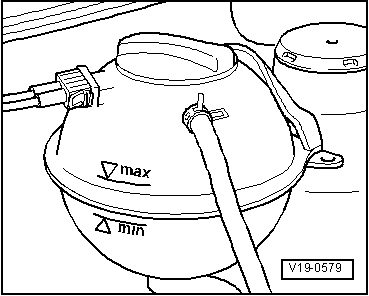|
Special tools, workshop equipment, test and measuring appliances and auxiliary items required
-
◆ T10007 Refractometer
-
◆ V.A.G 1306 Drip tray
-
◆ VAS 5024 Assembly tool for spring-type clamps
Draining
-
‒ Open cap on coolant expansion tank.
Warning !
Steam can be released when removing the cap from the expansion tank. Cover cap with a cloth and open carefully.
-
‒ Drain coolant from bottom radiator hose.
-
‒ Pull off lower coolant hose at radiator using assembly tool for spring-type clamps VAS 5024.
Note:
Observe disposal regulations for coolant!
Filling
Notes:
-
◆ Only use coolant additive G 12 in accordance with TL VW 774 F.
Distinguishing feature: coloured violet
-
◆ G 12 violet (in accordance with TL VW 774 F) can be mixed with the previous coolant additive G 12 red!
-
◆ G 12 and coolant additives marked "In accordance with TL VW 774 F" prevent frost and corrosion damage, scaling and also raise boiling point of coolant. For this reason the system must be filled all year round with frost and corrosion protection additives.
-
◆ Because of its high boiling point, the coolant improves engine reliability under heavy loads, particularly in countries with tropical climates.
-
◆ Protection against frost must be assured to about -25 °C (in arctic climatic countries to about -35 °C).
-
◆ The coolant concentration must not be reduced by adding water even in warmer seasons and in warmer countries. The anti-freeze ratio must be at least 40 %.
-
◆ If for climatic reasons a greater frost protection is required, the amount of G 12 can be increased, but only up to 60 % (frost protection to about -40 °C), as otherwise frost protection is reduced again and cooling effectiveness is also reduced.
-
◆ The refractometer T10007 is recommended for determining the current anti-freeze density.
-
◆ If radiator, heat exchanger, cylinder head or cylinder head gasket is replaced, do not reuse old coolant.
Recommended mixture ratios:
|
Frost pro- tection to
|
Anti-freeze amount
|
G 121)
|
Water1)
|
|
-25 °C
-35 °C
|
40 %
50 %
|
2.4 ltr.
3.0 ltr.
|
3.6 ltr.
3.0 ltr.
|
1)
The quantity of coolant can vary depending upon the vehicle equipment.
Work sequence
-
‒ Secure lower coolant hose on connecting piece of radiator.
With cooling system charging unit VAS 6096
-
‒ Fill coolant circuit using cooling system charging unit VAS 6096.
=> Operating instructions for cooling system charging unit VAS 6096
|

